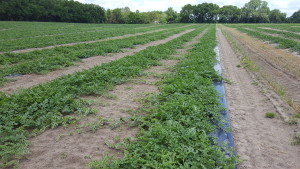 North Florida continues to have a large acreage of watermelons and the crop has started under good conditions. Thanks to Gene McAvoy, Regional Vegetable Extension Agent in Hendry County, Florida for the following update of powdery mildew on watermelons in South Florida. Mr. McAvoy cautioned that dry conditions are ideal for the development of powdery mildew in watermelons and other cucurbits. Please see his comments:
North Florida continues to have a large acreage of watermelons and the crop has started under good conditions. Thanks to Gene McAvoy, Regional Vegetable Extension Agent in Hendry County, Florida for the following update of powdery mildew on watermelons in South Florida. Mr. McAvoy cautioned that dry conditions are ideal for the development of powdery mildew in watermelons and other cucurbits. Please see his comments:
Powdery mildew of watermelon is a fairly recent phenomenon in Florida. Within the past few years, powdery mildew of watermelon has been on the increase in many watermelon production areas in Florida and powdery mildew is now showing up widely in melon fields around South Florida. Historically, powdery mildews tend to be more severe on plants grown in drier climates. Dry weather limits diseases like gummy stem blight but favors powdery mildew, because powdery mildew spores contain water that allows them to germinate on dry leaves.
Powdery mildew develops rapidly under favorable conditions. Symptoms of powdery mildew of watermelon appear as yellow blotches on the oldest leaves first. If untreated the fungus quickly spreads to completely affect the entire leaf. As the disease progresses these blotches become bronzed and turn dark brown or purplish. Eventually the leaf dies and has a crisp texture.
Powdery mildew can be difficult to diagnose in the field as the white masses of sporulation that are frequently seen with powdery mildew on other crops are not commonly seen with the powdery mildew of watermelon. In some cases affected leaves may display the typical yellowing, bronzing, and a fair amount of white powdery fungal growth. Often little or no white powdery mycelia are present and in these cases microscopy may be necessary to find a limited amount of the powdery mildew fungus in the yellowed areas. Powdery mildew develops quickly under favorable conditions. The time between infection and symptom appearance is only 3 to 7 days and a large number of conidia can be produced in a short time.
Crop rotation and many other cultural practices have limited effect on the incidence and development of powdery mildew. In general, healthy, vigorous leaves and stems are less prone to infection. Plants under nutritional stress in most cases will develop powdery mildew much sooner than plants the same age grown under a good nutritional program.
Growers should check 10 plants per field and 5 leaves per plant for a total of 50 leaves. Initial infections often occur on older leaves near the crown of the plant. Be sure to check both the upper and lower side of each leaf.
The fungus is best controlled with fungicide applications when symptoms are first observed. Early in the crop preventative applications of chlorothalonil (Note: chlorothalonil should not be used after fruit have begun to size to avoid sunburning), will provide some protection against powdery mildew.
Once the disease has been detected growers should switch to more efficacious materials such as Folicur, Fontelis, Inspire Super, Luna Sensation, Pristine, Quintec , Switch and Torino which have all shown good efficacy. Note some of these materials have a 7 PHI and may not be appropriate for use during the harvest period so be sure to check the label. Do not stop spraying until one week before the final pick.
